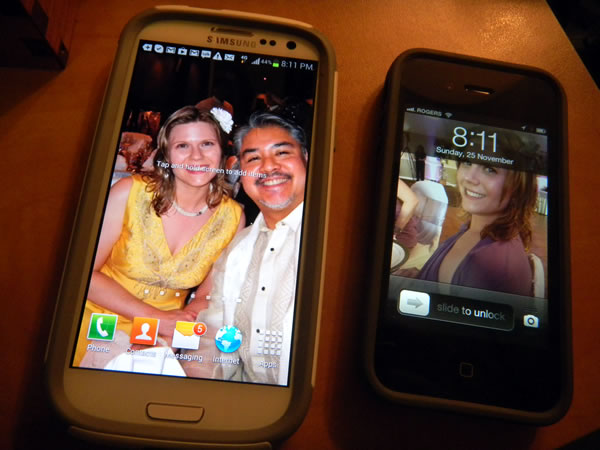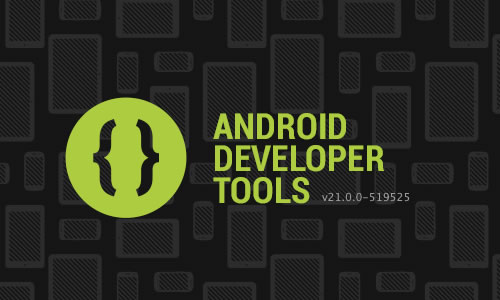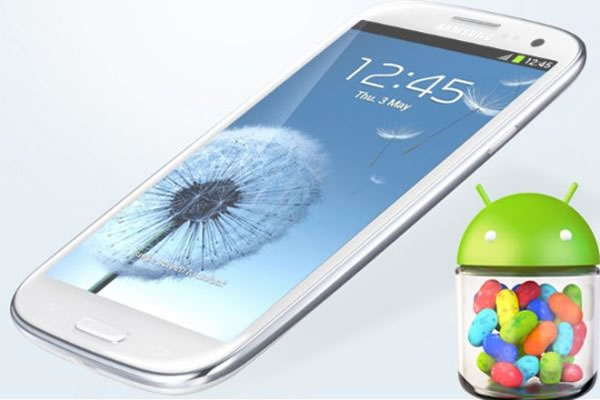
My Galaxy S III and iPhone 4.
I’m overseeing the development of a mobile diagnostics app for both iPhone and Android, but I’ve been using my cofounder’s Samsung Galaxy Note as my Android testing machine. It was high time that I stopped using his and got my own, so I paid a visit to Rogers a couple of weeks ago and picked up Samsung’s current flagship phone, the Galaxy S III. My primary SIM card currently lives in it, while my secondary one has taken up residence in my iPhone 4S. I’m one guy on Rogers’ family plan, so I have a third phone number and matching SIM; I’ll see how the BlackBerry/Windows Phone kumite for Distant Third Place shapes out and I’ll drop that SIM into the “winner” (for lack of a better word).
As you can see from the photo above, the Galaxy S III seems considerably larger than the iPhone 4S. It made me glad that I didn’t opt for the even larger Galaxy Note II, which I suspect is a plot to bring back those cargo pants from the ’90s. I have the white 16GB model, which I put in a white OtterBox as a defensive move against Murphy’s Law and as a result of having watched Android Authority’s “iPhone 5 vs. Galaxy S III drop test” video:
(The white Galaxy S III inside a white OtterBox has a certain Space: 1999 charm to it.)
I had my last Android device during my Microsoft days as a competitive research device. It was a Sony Experia X10 running the janky old 1.6 edition of Android, and while it was a damn sight better than the even-more-janky-if-such-a-thing-is-possible Windows Mobile 6, it didn’t quite have the polish that the iOS of that era (version 3, back when it was still called iPhone OS instead of iOS). I’d since noodled with other Android devices as time went by, and they all had the same problems: the not-quite-right UI that was at least in part hastily cribbed off Apple and that jittery, jerky scrolling that reminded you that you were most certainly not on an iPhone. The UI and scrolling are a good deal better with the 4.0 version, and thus far, nothing on the Galaxy S III has made me want to say “Screw it, I’m putting my primary SIM back in the 4S”. I’ll probably switch primary phones from time to time, but so far, my experiences with the Galaxy S III have been quite good.

In addition to teaching myself iOS development (which is going nicely, even though I haven’t been able to dedicate as much time to it as I’d like), I’ve started noodling with Android development, which takes me back to a language I haven’t touched since its 1.2 days: Java. In my opinion, C# has taken on a lot of features and syntactic sweetening that make it a better Java than Java, but Java is what you use to write Android apps, so I guess I’ll just have to take it on the chin. I have similar complaints about Eclipse — it’s got all the hallmarks of design-by-committee — but I’ve dealt with worse. At least getting the stuff you need to develop Android apps has become much simpler: it’s all in one place with the ADT Bundle; you can just download it and (mostly) go. You still have to go through the dance of fetching emulators, but after some very quick searching around, this video pointed me in the right direction. After that, I dove into the world of activities and intents.

Last evening, while my Galaxy was plugged into my MacBook Pro, I got an alert saying that there was new firmware available for my phone. It turned out to be the Android 4.1 (a.k.a. “Jellybean”) upgrade that Samsung Canada has promised to Galaxy S III users in early December (the stock Galaxy S III comes with Android 4.0, a.k.a. “Ice Cream Sandwich”). The upgrade installed without any technical problems, but I have one complaint: the upgrade app for the Mac is hardcore modal. Its window insists on being the topmost all the time and soaks up most keyboard and mouse events, making your Mac largely useless for other work as it downloads and installs the new Android. Luckily, I was running the upgrade before going to bed.
So far, nitpicks aside, I’ve had a pretty decent experience with the Galaxy and Android.
8 replies on “Diving into Android”
Did you see this one on Objective-C as the language of the future?
https://www.evernote.com/shard/s9/sh/e851f7cb-f634-4fe9-912f-eb25b4af2fee/918eb1fa11aa3b9e63e898186163d254
Also a few random Android development notes:
http://code.davidjanes.com/blog/category/android/
Check out AIDE. Android development on android. Not necessarily the best way to do it, but technically very interesting.
Have you tried IntelliJ IDEA as an IDE for Android development?
http://www.jetbrains.com/idea/features/android.html
At my workplace, we started making the switch after Eclipse kept unexpectedly crashing on a large Android project.
If you’re doing Android and iOS development then you might want to check out what the guys at xamarin.com are up to. C# and .net running on both platforms. I’ve been using Mono for Android since that start of the year and am very impressed.
Seriously, check out Embarcadero’s RAD Studio XE3 developer’s platform. With their Firemonkey environment, you can develop for Android or iOS with a single codebase.
[…] side, reports of Apple fans taking up Android devices and enjoying them continue to pop up. I myself picked up a Galaxy S III a month ago and have made it my primary phone for the time being. It’s quite enjoyable, and I have yet to […]
[…] so, so Samgsung-y. That’s a real shame, because they do produce good stuff (I myself count a Galaxy S3 and a number of Samsung monitors among my […]
[…] about iOS development, but Android development is also in my sights as well. One of the reasons I picked up a Samsung Galaxy S III last year was to get learn how to write Android apps, an undertaking that’s been delayed by life, work, […]